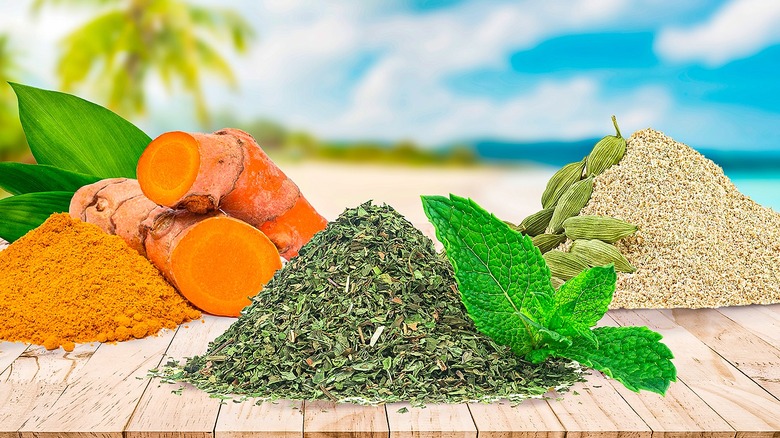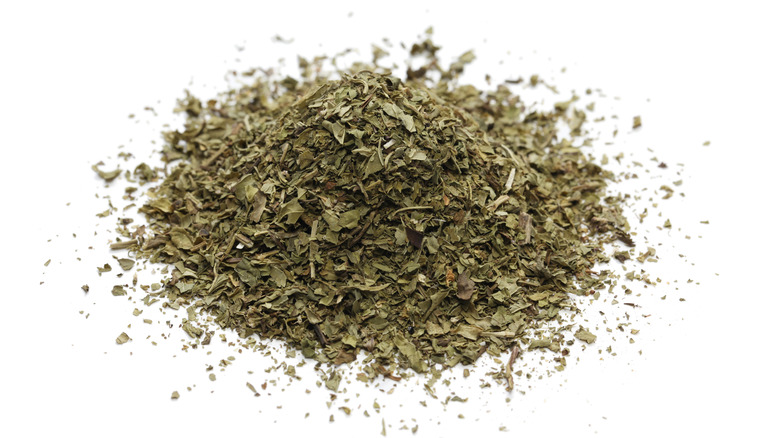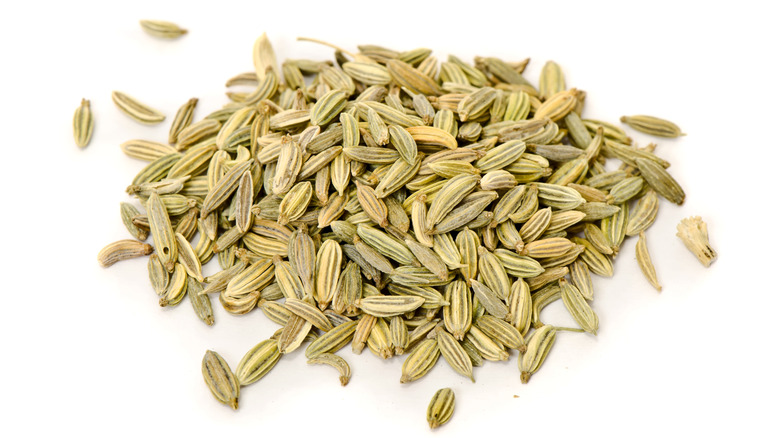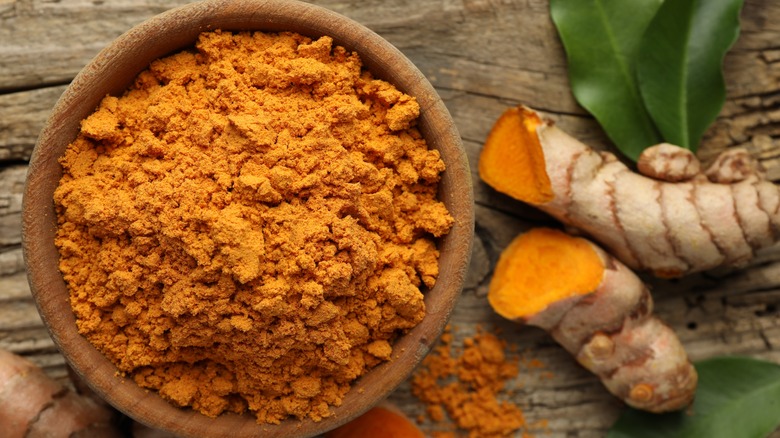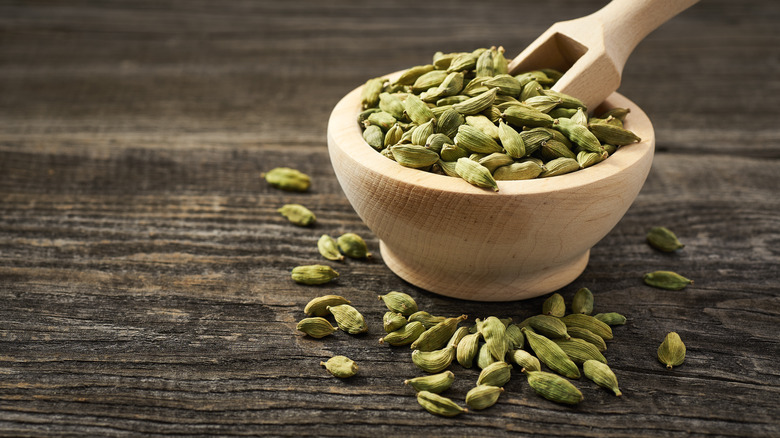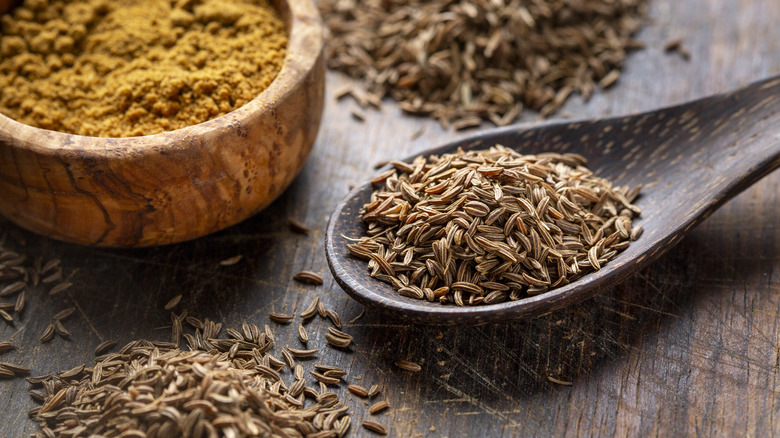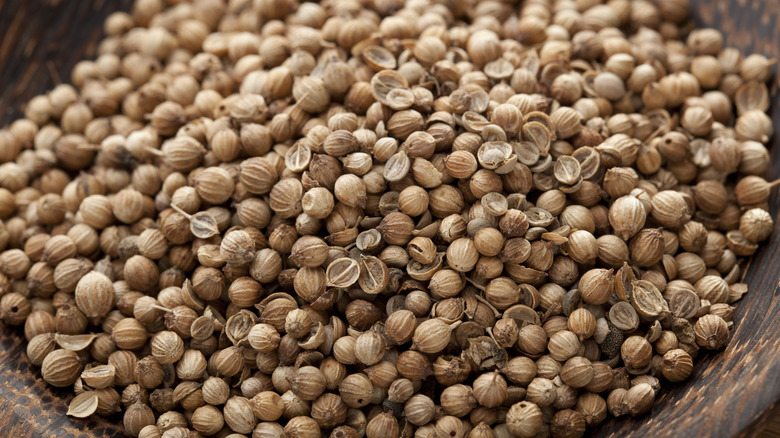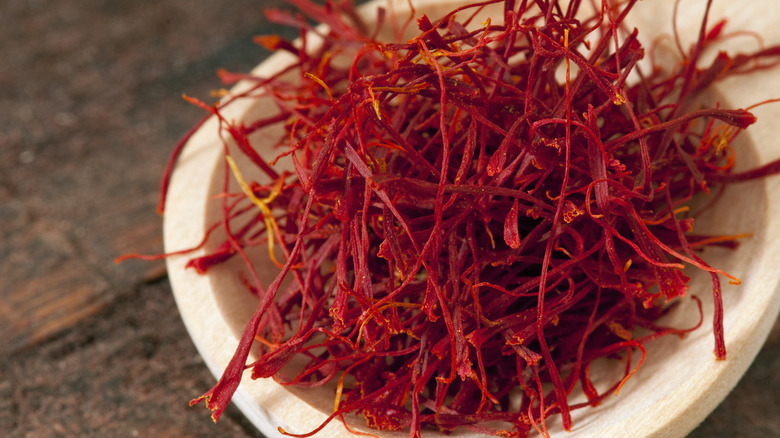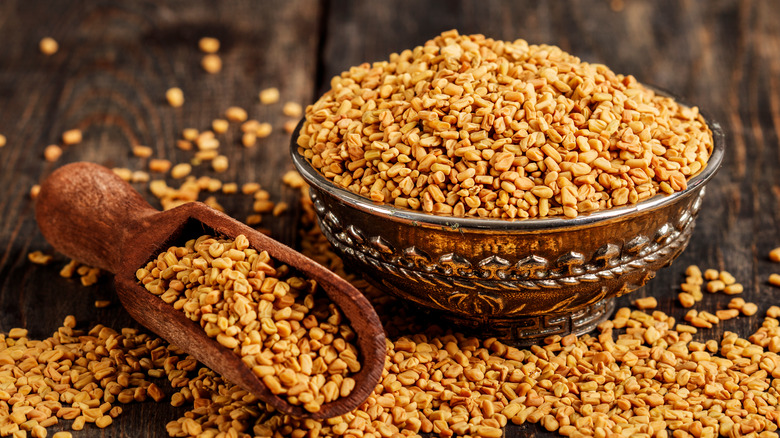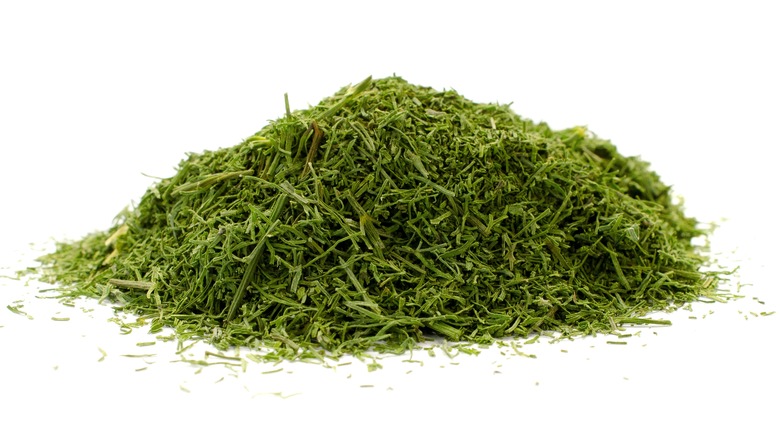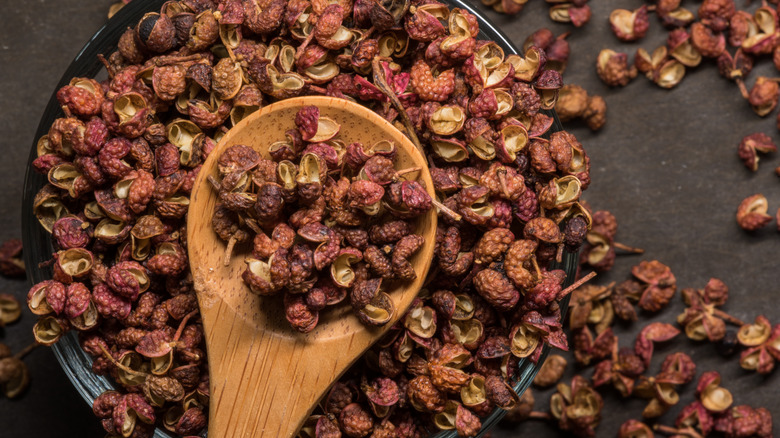11 Cooling Spices You Should Incorporate In Your Meals This Summer
When temperatures rise and the desire for something refreshing strikes, you don't need to resort to eating popsicles for breakfast, lunch, and dinner. Spices can have a cooling or warming effect when you add them to your recipes, allowing you to fine-tune the dining experience you're after. While you can play with these characteristics for culinary purposes, the physical sensations can also be quite potent.
Several spices have properties that can cool you down, from unique protein compounds to anti-inflammatory aspects. The latter is especially useful: As registered dietitian nutritionist Nancy Park describes it, "[Inflammation is] like a smoldering fire inside of your body" — banking that fire is essential to health. Some spices can also facilitate digestion, while others increase hydration or cause you to sweat more. Such principles are common in some types of Eastern medicine, including Ayurveda, which uses spices and foods to achieve energy balance.
You don't need to be a proponent of these philosophies to see how dietary changes can regulate your temperature and promote general feelings of wellness, though — some dishes just hit right when you're looking for a way to cool down. Here are the cooling spices you'll want to start using in your meals this summer as the numbers on the thermometer rise.
Mint
Mint displays its refreshing qualities quite readily. This is largely because mint leaves contain menthol, which is made up of a protein that we perceive as similar to cold temperature foods, according to a 2007 study published in Nature. Menthol can also help reduce feelings of thirst, making it extra pleasant to add to your meals on a hot summer day.
This hugely versatile herb carries a lot of weight in the culinary world, whether you use it fresh from the garden or dried as a seasoning. For an easy way to include it in your diet, just add fresh leaves to hot or cold water. Many countries with a warm climate have a tradition of drinking mint tea, and it's no wonder why — it's easy to do so, and enormously refreshing. Step things up a notch by making a classic mint julep or a mojito cocktail. Mint also adds plenty of freshness to salads, such as in an herby tabouli, Israeli couscous, and even fruit salad. Use it as a simple garnish, or combine it with nuts for an easy pesto variation. You don't have to stick with spearmint or peppermint, either; the mint family is vast and includes herbs like lemon balm and marjoram.
Fennel seed
Fennel bulbs are an excellent addition to raw and roasted veggie mixes, but the plant's seed brings about its own gustatory experience not to be missed. A little smaller than a grain of rice and typically pale green in color, fennel seeds are often used in tea or chewed on solo to aid with digestion following a meal. They're also used to help regulate body temperature, cooling you down in the summer heat. In fact, in hot regions in India, it is common for people to chew on them to prevent heat stroke as the thermometer levels rise.
Fennel seeds make an excellent seasoning for an assortment of recipes, infusing a subtly sweet licorice-like taste into vegetables, meats, and pasta dishes. Add the seeds to a first-class steak seasoning mix, or mix them into ground beef for meatballs. Give your tomato sauce a flavor boost by stirring in ground, chopped, or whole seeds. If you're steering clear from stovetop or oven preparations due to heat, add the seeds to a vinaigrette and drizzle it over a thinly sliced fennel bulb to double down on flavor.
Turmeric
Turmeric is widely praised for its anti-inflammatory properties and associated benefits. These are all thanks to various active compounds, including curcumin. Indeed, curcumin appears to have a cooling effect on the body and can help regulate body temperature, in part due to anti-inflammatory action. Whether you're using the freshly grated root or sprinkling dried powder into a recipe, turmeric is easy to incorporate into a wide variety of dishes.
In the kitchen, it's an important component of many curry blends, and pairs well with coconut milk. Try coconut curry mussels with your daily catch, or whip up a fresh, aromatic Thai shrimp curry for another seafood option. Add a vibrant hue and earthy notes to simple white rice with this seasoning — if you want to get fancy, try making an easy Persian rice tahdig. Don't only serve turmeric with your main meal, either; just a few pinches of turmeric will transform ice cream and mocktails alike.
Cardamom
You might think of cardamom alongside cinnamon in a warmly spiced loaf, but the green pods are actually classified as being on the cooling spectrum in Ayurvedic philosophy. Usually, the three main types of energy described in Ayurvedic medicine require different diets to be balanced, but cardamom is believed to temper them all. As a potentially anti-inflammatory spice, it also has a multitude of excellent health benefits. If the heat feels overwhelming, a bit of cardamom may bring a refreshing sensation.
Cardamom has citrusy and floral elements, with a peppery, menthol-like aroma adding some zest. Traditionally, it's used as a breath freshener and included in some chewing gums. It works well in sweet and savory dishes, making it a versatile spice to incorporate into your summertime recipes. Just make sure you're purchasing the small green pods instead of the larger black ones, which tend to have more of a warming effect.
Keep things extra simple by adding a teaspoon of powdered cardamom to your coffee as it brews, or sip on cardamom tea following a meal for smooth digestion and to cool down your senses. It's a delicious component of a simple tea cookie or apple cake, infusing those treats with rich fragrance and bright aroma. Add a few pods to plain white rice as it steams for a surprising and subtle variation, or incorporate them into a coconut milk curry.
Cumin seed
Cumin seeds are more pungent than the ground version, with earthy, nutty notes and a citrus element. Toasting them highlights these aromas, whereas grinding the seeds brings out more of a floral essence. In Ayurvedic medicine, the seeds are commonly soaked in water and served as a beverage to hydrate the body and reduce the effects of heat on hot days. Known as jeera water, the popular refreshment is believed to cool down the body when temperatures are high and relief is scarce. It also promotes healthy digestion, which can prevent you from feeling weighed down. Simply boil whole or lightly crushed cumin seeds for 20 minutes, then strain them off and let the water cool down before sipping.
Of course, you don't have to stick to drinking spiced water to enjoy the cooling effects of cumin. The spice is incredibly versatile and shows up in various cuisines from across the globe. Try it in curry, baked rice, stew, soup, or a simple meat dish. A hearty chicken mulligatawny is an excellent backdrop for the spice, or you can stick to using it in a potato dish like spicy aloo curry.
Coriander seed
Coriander's many purported benefits include regulating body temperature in the warmer months. In Ayurveda, it is used medicinally and in the diet to help balance out various energies in the body. With its anti-inflammatory properties and digestive benefits, coriander is an excellent addition to your summer recipes. Similar to cumin seeds, it is commonly used to infuse water to make a refreshing beverage. You can either boil the seeds in water and strain them, or soak them overnight, crushing them to add more of the spice's essence.
There are plenty of creative ways to cook with coriander seeds, so you don't have to resort to drinking aromatized water alone. You can use them solo or combine them with cumin or fennel for an all-purpose spice blend. Keep them raw or toast the seeds to emphasize the citrusy notes for more depth. Add them to chutneys, sauces, curries, or even in a meat rub. A simple yet decidedly flavor-packed option is to toast the seeds in oil and use them as a garnish, which is especially delicious when used to top butterflied leg of lamb.
Saffron
Saffron infuses everything it touches with a golden hue, and if you add it to your summertime recipes, you'll soon learn it's just as generous with its cooling properties. The deep red threads come from a flower, which is noticeable in their subtly sweet floral aroma. Balanced with earthiness and a light bitterness, saffron can be used in sweet and savory recipes. The spice is known for its anti-inflammatory properties, which once again translate to a capacity to cool down the body in warmer temperatures. Additionally, saffron can be soothing, making it an excellent ingredient for summer dishes.
Some people go straight for infused water or a cold saffron lemonade to enjoy the benefits of the spice, but it pairs just as well with a wide variety of foods. Add a few threads to steamed rice or a rice pilaf, sprinkle them into a coconut milk stew, or toss them into a simple buttery saffron pasta recipe. Saffron works well with cream based desserts too; try it with yogurt or in ice cream for a unique twist. A little goes a long way.
Fenugreek seed
Fenugreek is delicious, but fairly pungent. Toasting the seeds helps tame the intensity and bring out its sweet and nutty taste. If you want to maximize their supposed cooling properties during a heat wave, chew on the raw seeds or soak them in water overnight before straining them off and drinking the liquid in the morning.
There are plenty of other palatable ways to experience fenugreek's effects as well. Start by toasting the seeds along with other seeds if desired, such as cumin and coriander, to triple down on the cooling qualities while balancing out the prominent flavor. Use them as a component of a curry spice blend to season mild ingredients like potatoes, paneer, or lentils. You can also toss the seeds into a stir-fry or incorporate them into a chutney recipe or pickling solution for a bold addition. If you're a fan of veggie fritters, season them with a small spoonful of fenugreek seeds to add nuttiness and a refreshing element.
Dill
If the summer temperatures have you sweating, integrating dill into your dishes is a great idea. The spice is sold as dill weed or as dill seed, dried, ground, and fresh. These options differ in taste, with the leafy component being more fragrant and similar to anise, whereas the seed is bolder and similar to caraway. Use any of them to harness the spice's cooling powers.
Enjoy dill weed or seed in numerous dishes, either as a background flavor or at center stage. It pairs nicely with cream-based foods, such as rich soups or smooth yogurt dips. It is an especially excellent match for salmon, whether you're serving a whole filet, patties, or a smoked salad. For a nourishing meal that doesn't require too much heat from the stove, try an omelet seasoned with dill. Or, if you can't bear the thought of heating a pan, toss thinly sliced cucumber with dill weed and vinegar for a tangy salad.
Sichuan peppercorn
If you've ever eaten Sichuan food, then you're familiar with this infamous peppercorn and its buzzy mouthfeel. Although it vaguely looks like one, the zingy spice isn't actually a peppercorn, but a dried berry from a shrub. It definitely brings some heat to your meal, but the compounds involved are distinct from the capsaicin found in chili peppers. Instead of a notable burning sensation, your lips and palate will feel numb and tickly. It will also cause you to sweat, ultimately bringing down your body temperature. This bodes well in the peppercorn's place of origin, where hot days involve high levels of humidity that have inhabitants aching for relief.
There's nothing quite like eating a meal loaded with Sichuan peppercorns, and summertime is a great opportunity to experiment with their full spectrum of effects. Look toward Sichuan cuisine for traditional ways to use the spice. Whip up spicy garlic noodles or go all out with a Chinese dry pot, loaded with chicken wings, seafood, ribs, and vegetables. Or, keep it simple by sprinkling them into a sautéed ground pork dish or on top of green beans or mixed vegetables.
Vanilla
You may be most accustomed to using vanilla in your baked goods, but it can also be used in a number of other ways. Experimenting with it in the summertime heat is a great idea, as vanilla has the added benefit of cooling down your body temperature. In some instances, it is even used to help tame fever.
In the summer, opting for a cone of vanilla ice cream is a no-brainer; stop by your favorite ice cream shop for a scoop, or pick up a pint of store-brand vanilla ice cream for an easy fix. Make your morning a little cooler by adding a few drops of pure vanilla bean extract to your smoothie. For a unique sweet and savory combo, add vanilla to roasted veggies to bring out their caramelized aromas, or to meat marinades for more complexity. To wash it all down, make a vanilla syrup to add to sparkling water.
